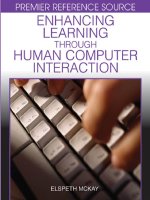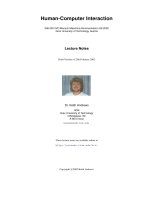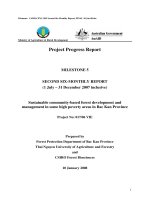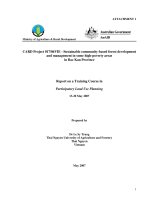human computer interaction development and management
Bạn đang xem bản rút gọn của tài liệu. Xem và tải ngay bản đầy đủ của tài liệu tại đây (3.59 MB, 336 trang )
IRM PRESS
Tonya Barrier
Human Computer
Interaction Development
& Management
Human Computer
Interaction Development
and Management
Tonya Barrier, Ph.D.
Southwest Missouri State University, USA
IRM Press
Publisher of innovative scholarly and professional
information technology titles in the cyberage
Hershey • London • Melbourne • Singapore • Beijing
Acquisitions Editor: Mehdi Khosrow-Pour
Managing Editor: Jan Travers
Assistant Managing Editor: Amanda Appicello
Copy Editor: Amanda Appicello
Cover Design: Tedi Wingard
Printed at: Integrated Book Technology
Published in the United States of America by
IRM Press
1331 E. Chocolate Avenue
Hershey PA 17033-1117
Tel: 717-533-8845
Fax: 717-533-8661
E-mail:
Web site:
and in the United Kingdom by
IRM Press
3 Henrietta Street
Covent Garden
London WC2E 8LU
Tel: 44 20 7240 0856
Fax: 44 20 7379 3313
Web site:
Copyright © 2002 by Idea Group Inc. All rights reserved. No part of this book may be
reproduced in any form or by any means, electronic or mechanical, including photocopy-
ing, without written permission from the publisher.
Library of Congress Cataloguing-in-Publication Data
Human computer interaction development and management / [edited by] Tonya Barrier.
p. cm.
Includes bibliographical references and index.
ISBN 1-931777-13-6 (paper)
1. Human-computer interaction. I. Barrier, Tonya, 1959-
QA76.9.H85 H8565 2002
004'.01'9 dc21 2002017315
eISBN: 1-931777-35-7
British Cataloguing-in-Publication Data
A Cataloguing-in-Publication record for this book is available from the British Library.
Other New Releases from IRM Press
Excellent additions to your institution’s library!
Recommend these titles to your Librarian!
To receive a copy of the IRM Press catalog, please contact
(toll free) 1/800-345-4332, fax 1/717-533-8661,
or visit the IRM Press Online Bookstore at: []!
Note: All IRM Press books are also available as ebooks on netlibrary.com as well as
other ebook sources. Contact Ms. Carrie Stull at [] to receive
a complete list of sources where you can obtain ebook information or
IRM Press titles.
• Effective Healthcare Information Systems, Adi Armoni (Ed.)
ISBN: 1-931777-01-2 / eISBN: 1-931777-20-9 / approx. 340 pages / US$59.95 / © 2002
• Data Warehousing and Web Engineering, Shirley Becker (Ed.)
ISBN: 1-931777-02-0 / eISBN: 1-931777-21-7 / approx. 334 pages / US$59.95 / © 2002
• Information Technology Education in the New Millennium, Mohammad Dadashzadeh,
Al Saber and Sherry Saber (Eds.) /
ISBN: 1-931777-05-5 / eISBN: 1-931777-24-1 / approx. 308 pages / US$59.95 / © 2002
• Information Technology Management in Developing Countries, Mohammad Dadashzadeh
(Ed.) / ISBN: 1-931-777-03-9 / eISBN: 1-931777-23-3 / approx. 348 pages / US$59.95 / © 2002
• Strategies for eCommerce Success, Bijan Fazlollahi (Ed.)
ISBN: 1-931777-08-7 / eISBN: 1-931777-29-2 / approx. 352 pages / US$59.95 / © 2002
• Collaborative Information Technologies, Mehdi Khosrow-Pour (Ed.)
ISBN: 1-931777-14-4 / eISBN: 1-931777-25-X / approx. 308 pages / US$59.95 / © 2002
• Web-Based Instructional Learning, Mehdi Khosrow-Pour (Ed.)
ISBN: 1-931777-04-7 / eISBN: 1-931777-22-5 / approx. 322 pages / US$59.95 / © 2002
• Modern Organizations in Virtual Communities, Jerzy Kisielnicki (Ed.)
ISBN: 1-931777-16-0 / eISBN: 1-931777-36-5 / approx. 316 pages / US$59.95 / © 2002
• Enterprise Resource Planning Solutions and Management, Fiona Fui-Hoon Nah (Ed.)
ISBN: 1-931777-06-3 / eISBN: 1-931777-26-8 / approx. 308 pages / US$59.95 / © 2002
• Interactive Multimedia Systems, Syed M. Rahman (Ed.)
ISBN: 1-931777-07-1 / eISBN: 1-931777-28-4 / approx. 314 pages / US$59.95 / © 2002
• Ethical Issues of Information Systems, Ali Salehnia (Ed.)
ISBN: 1-931777-15-2 / eISBN: 1-931777-27-6 / approx. 314 pages / US$59.95 / © 2002
• Intelligent Support Systems: Knowledge Management, Vijay Sugumaran (Ed.)
ISBN: 1-931777-00-4 / eISBN: 1-931777-19-5 / approx. 318 pages / US$59.95 / © 2002
• Human Factors in Information Systems, Edward Szewczak and Coral Snodgrass (Eds.)
ISBN: 1-931777-10-1 / eISBN: 1-931777-31-4 / approx. 342 pages / US$59.95 / © 2002
• Global Perspective of Information Technology Management, Felix B. Tan (Ed.)
ISBN: 1-931777-11-4 / eISBN: 1-931777-32-2 / approx. 334 pages / US$59.95 / © 2002
• Successful Software Reengineering, Sal Valenti (Ed.)
ISBN: 1-931777-12-8 / eISBN: 1-931777-33-0 / approx. 330 pages / US$59.95 / © 2002
• Information Systems Evaluation Management, Wim van Grembergen (Ed.)
ISBN: 1-931777-18-7 / eISBN: 1-931777-37-3 / approx. 336 pages / US$59.95 / © 2002
• Optimal Information Modeling Techniques, Kees van Slooten (Ed.)
ISBN: 1-931777-09-8 / eISBN: 1-931777-30-6 / approx. 306 pages / US$59.95 / © 2002
• Knowledge Mapping and Management, Don White (Ed.)
ISBN: 1-931777-17-9 / eISBN: 1-931777-34-9 / approx. 348 pages / US$59.95 / © 2002
Human Computer Interaction
Development and Management
Table of Contents
Foreword vii
Preface viii
Chapter 1. Towards User-Oriented Control of End-User Computing in
Large Organizations 1
Neil McBride, DeMontfort University, United Kingdom
A. Trevor Wood-Harper, University of Salford, United Kingdom
and University of South Australia, Australia
Chapter 2. On-Line User Interaction with Electronic Catalogs:
Language Preferences Among Global Users 18
Aryya Gangopadhyay and Zhensen Huang
University of Maryland Baltimore County, USA
Chapter 3. End Users as Expert System Developers? 31
Christian Wagner, City University of Hong Kong, China
Chapter 4. Designing End-User Geographic Information
Systems 53
Lawrence West, Jr., University of Central Florida, USA
Chapter 5. Hypermedia Document Management: A Metadata and
Meta-Information System 71
Woojong Suh and Heeseok Lee
Korea Advanced Institute of Science and Technology, Korea
Chapter 6. An Adaptive Probe-Based Technique to Optimize Join
Queries in Distributed Internet Databases 93
Latifur Khan, University of Texas at Dallas, USA
Dennis McLeod and Cyrus Shahabi, University of Southern
California, USA
Chapter 7. Strategies for Managing EUC on the Web 117
R. Ryan Nelson, University of Virginia, USA
Peter Todd, University of Houston, USA
Chapter 8. Exploring the Measurement of End User Computing
Success 134
Conrad Shayo, California State University of San Bernardino, USA
Ruth Guthrie, California Polytechnic University of Pomona, USA
Magid Igbaria, Claremont Graduate University, USA
Chapter 9. Constructive Design Environments: Implementing
End-User Systems Development 153
John G. Gammack, Murdoch University, Australia
Chapter 10. An Information Systems Design Framework for
Facilitating TQM Implementation 174
Nazim U. Ahmed, Ball State University, USA
Ramarathnam Ravichandran, Design Systems, USA
Chapter 11. Methodology of Schema Integration for New
Database Applications: A Practitioner’s Approach 194
Joseph Fong, City University of Hong Kong, China
Kamalakar Karlapalem, Hong Kong University of Science &
Technology, China
Qing Li and Irene Kwan, Hong Kong Polytechnic University, China
Chapter 12. CMU-WEB: A Conceptual Model for
Designing Usable Web Applications 219
Akhilesh Bajaj and Ramayya Krishnan
Carnegie Mellon University
Chapter 13. The Effects of Using a Triangulation Approach of
Evaluation Methodologies to Examine the Usability of a University
Website 243
Dana H. Smith, Zhensen Huang, Jennifer Preece and Andrew Sears
University of Maryland, Baltimore County, USA
Chapter 14. Adaptive Web Representation 255
Arno Scharl, Vienna University of Economics, Austria
Chapter 15. Usability: Changes in the Field – A Look at the System
Quality Aspect of Changing Usability Practices 261
Leigh Ellen Potter, Griffith University, Queensland, Australia
Chapter 16. Facilitating End User Database Development by
Working with Users’ Natural Representations of Data 271
Valerie J.Hobbs and Diarmuid J. Pigott
Murdoch University, Australia
Chapter 17. User Developed Applications: Can End Users Assess
Quality? 289
Tanya J. McGill, Murdoch University, Australia
Chapter 18. Toward an Understanding of the Behavioral Inten
tion to Use A Groupware Application 304
Yining Chen and Hao Lou, Ohio University, USA
About the Editor 314
Index 315
Foreword
With the advent of new technology and new software, comes the management
of the information systems of the organization. Technology and software development
is at an all time high. Management of the information systems area is very complex
and volatile.
Organizations today realize that information systems must be managed.
Organizations cannot continue to blindly accept and introduce components into
information systems without studying the effectiveness, feasibility and efficiency of
the individual components of their information systems. Information systems may
be the only business area where it is automatically assumed that the “latest, greatest
and most powerful component is the one for our organization.” Information systems
must be managed and developed as any other resource in organizations today.
The purpose of this book is to collect articles concerning the management
and development of information systems so that organizations can effectively
manage information systems growth and development in their organization.
The management of information systems within the organization is a diverse
area. Not only must hardware, software, data, information, and networks must be
managed, but also, people must be managed. Humans must be trained to use
information systems. Systems must be developed so humans can use the systems
as efficiently and effectively as possible. Therefore, topics included in this book
concern human computer interaction such as training, aesthetics, ergonomics, and
user friendliness. Questions posed may be: What monitor size is best? What desk
height is best? Which colors should I use on outputs? What kinds of hardware
should I provide for my physically challenged workers? How should I build a
workstation to reduce problems such as carpal tunnel syndrome? What kinds of
training programs are best? When should we update our hardware and software?
The list of questions regarding the physical requirements for humans is infinite.
However, the topic of human computer interaction is not complete without the study
vii
viii
of organizations, humans and information systems.
Organizations have changed with the introduction of technology. The
Internet and extranet along with the concept of electronic messaging systems have
changed the way organizations communicate. On the whole, organizations have
increased and improved communications. However, theses same communication
channels have introduced more IT security and more problems especially with the
“new e-mail” viruses. These concepts must be managed.
Organizational structural changes have been made because organizations
expect individuals to be more productive as technology is introduced. Such
organizations are continually “right sizing” and changing roles as technology
changes. Today most individuals are responsible for many of their “own” technological
needs. These concepts must be managed.
Employee training, and management training is evolving. The introduction
of IT has produced new mediums for development and training such as online
multimedia training to group decision making using IT. These concepts must be
managed.
It would be impossible to list individually the topics concerning human
computer interaction development, organizations, organizations changes, new
technology and the management of IT. The purpose of this book is to gather a
useful set of articles to describe human computer interaction development and
management of organizations. The authors of the individual manuscripts have
written the articles to further the effective management and development of IT in
organizations. I invite you to peruse the book to find the article that best suits your
needs.
Tonya Barrier
Southwest Missouri State University, USA
ix
Preface
The human component of information systems use is an often overlooked, but
extremely important factor. The end user has to deal with all the problems with the
systems and understand how to utilize all the components of a given system in order
for the entire operation to be optimized. Many organizations are looking to the end
user when designing and implementing new systems, but in order to understand
what role these end users can and should play, organization heads and project
managers need to have access to the latest information regarding the human factor
in information systems development and management. This timely new book
provides the most up-to-date reporting on research and practice in the fields of end
user computing and human computer interaction. From geographic information
systems to online catalogs, the chapters in this book cover a wide range of topics
related to end users and provide practical as well as theoretical guidance on how
to best incorporate the human factor into design and management decisions. The
authors from a wide variety of organizational and cultural backgrounds, and experts
in their field share their insights in the following chapters.
Chapter 1 entitled, “Towards User-Oriented Control of End-User Computing
in Large Organizations” by Neil McBride of DeMontfort University and A. Trevor
Wood-Harper of the University of Salford (United Kingdom) and the University of
South Australia concentrates an IT-oriented view with an alternative user-oriented
view. The chapter advocates a shift in End User Computing research away from
the technology and the IT issues towards the political, social and cultural issues
associated with the users. The chapter proposes a dynamic model for EUC in which
the progression of EUC within an organization is visualized as a series of inference
loops.
Chapter 2 entitled, “Online User Interaction with Electronic Catalogs:
Language Preferences Among Global Users” by Aryya Gangopadhyay and
Zhensen Huang of the University of Maryland-Baltimore County (USA) describes
a bilingual electronic catalog that can be used by online retailers for selling products
and/or services to customers in either English or Chinese. The chapter reports on
three separate usages of the catalog: browsing, direct search and exact matches.
The authors test the efficiency of usage by measuring time spent as well as studying
the path followed by the user in retrieving information in all of the above scenarios.
Chapter 3 entitled, “End Users as Expert Systems Developers?” by Christian
Wagner of City University of Hong Kong (China) discusses the differences
associated with end user development, both in terms of design quality and
knowledge content. The chapter is based upon an analysis of 25 expert systems
written by non-professional developers. The report of the analysis within the
chapter reveals significant quality and size limitations that indicate limited feasibility
of end user expert system development.
Chapter 4 entitled, “Designing End-User Geographic Information Systems”
by Lawrence West, Jr. of the University of Central Florida (USA) identifies the
concepts most needed for end user geographic information systems (GIS) use and
suggests remedial efforts to reduce the burden of system operation and improve
data integrity. The chapter presents useful guidelines and offers approaches, which
make extensive use of metadata storage. These approaches may be implemented
as tools in GIS software provided to end-users.
Chapter 5 entitled, “Hypermedia Document Management: A Metadata and
Meta-Information System” by Woojong Suh and Heeseok Lee of Korea Advanced
Institute of Science and Technology (Korea) identifies metadata roles and components
necessary to build a metadata schema. The authors propose a meta-information
system, Hyperdocument Meta-Information systems (HyDoMiS), that performs
three functions, metadata management, search and reporting. The authors indicate
that this system will help to implement and maintain hypermedia information systems
effectively.
Chapter 6 entitled, “An Adaptive Probe-based Technique to Optimize Join
Queries in Distributed Internet Databases” by Latifur Khan of the University of
Texas at Dallas, Dennis McLeod and Cyrus Shahabi of the University of Southern
California (USA) discusses an experiment that consisted of two servers running the
same DBMS connected to the Internet. The authors discuss how a static query
optimizer could choose an expensive plan by mistake due to its lack of knowledge
about the run time environment, inaccurate statistical assumptions in size estimation
or neglect of the cost of remote method invocation. The authors present a probing
mechanism with an adaptive technique that offers a more cost effective approach
than the static query optimizer.
Chapter 7 entitled, “Strategies for Managing EUC on the Web” by R. Ryan
Nelson of the University of Virginia and Peter Todd of the University of Houston
(USA) examines which strategies organizations are using to maximize the benefits
of the Web for end users while mitigating the inherent risks. The authors surveyed
individuals from 12 organizations and report the results of their survey in this
chapter. The results indicate that organizations are doing an adequate job of
establishing roles, standards, and mechanisms; however, their efforts for resource
allocations, development management and maintenance are lacking.
x
Chapter 8 entitled, “Exploring the Measurement of End User Computing
Success” by Conrad Shayo of California State University of San Bernardino, Ruth
Guthrie of California Polytechnic University of Pomona and Magid Igbaria of
Claremont Graduate School (USA) explores the literature on EUC success
measurement and discusses the main issues and concerns researchers face. The
authors offer recommendations to optimize success measurement including using
unobtrusive measures of success, taking into account contextual factors, using well-
defined concepts and measures and seeking a comprehensive integrated models
that incorporate a global view.
Chapter 9 entitled, “Constructive Design Environments: Implementing End-
User Systems Development” by John Gammack of Murdoch University (Australia)
develops the case for centering definitions and process-flows on end users in their
active situations. The chapter examines the potential for basing integrated
information systems development upon the constructive and evolutionary processes
in client context. The chapter considers case studies and representative situations
at the levels of full application design, workflow definition and enterprise wide-
development.
Chapter 10 entitled, “An Information Systems Design Framework for
Facilitating TQM Implementation” by Nazim Ahmed of Ball State University and
Ramarathnam Ravichandran of Design Systems (USA) provides a framework for
information systems design for total quality management (TQM) implementation.
The framework consists of three phases: tasks, analyses of communication
effectiveness, and appropriate IS component inventories. The authors then apply
their framework to a hypothetical example of a large manufacturing firm.
Chapter 11 entitled, “Methodology of Schema Integration for New Database
Applications: A Practitioner’s Approach” by Joseph Fong of City University of
Hong Kong, Kamalakar Karlapalem of Hong Kong University of Science and
Technology and Qing Li and Irene Kwan of Hong Kong Polytechnic University
(China) presents a practitioner’s approach to integrating databases and evolving
them to support new database applications consisting of a joint bottom-up and top-
down approach.
Chapter 12 entitled, “CMU-WEB: A Conceptual Model for Designing
Usable Web Applications” by Akhilesh Bajaj and Ramayya Krishnan of Carnegie
Mellon University (USA) proposes a three-dimensional classification space for
Web applications, consisting of a degree structure of pages dimensions, a degree
of support for interrelated events dimension and a location of processing dimension.
The chapter then proposes a usability design metric for Web applications. The
authors use CMU-Web, a conceptual model used to design Web applications as
a way to measure these dimensions.
xi
Chapter 13 entitled, “The Effects of Using a Triangulation Approach of
Evaluation Methodologies to Examine the Usability of a University Website” by
Dana Smith, Zhensen Huang, Jennifer Preece and Andrew Sears of the University
of Maryland-Baltimore County (USA) report on the results of a study used to
evaluate the current University of Maryland Baltimore County Web in order to
identify problems to be addressed in the redesign project. With the analysis of the
results collected from gathering test data, observing users and interviewing
individuals from the campus, the authors were able to identify problems that could
be addressed. Furthermore, the authors demonstrated the value of using a
triangulation approach to devise these results.
Chapter 14 entitled, “Adaptive Web Representation” by Arno Scharl of
Vienna University of Economics (Austria) classifies hypertext applications into
three categories of information and their corresponding interface representation:
context of documents, primary navigational system comprising links between and
within the documents and supplemental navigational systems such as indexes, trails
or guided tours.
Chapter 15 entitled, “Usability: Changes in the Field – A Look at the System
Quality Aspect of Changing Usability Practices” by Leigh Ellen Potter of Griffith
University (Australia) examines traditional usability testing and compares it to user-
centered design practices focusing on the resultant quality of the information
system. The author examines the literature surrounding each approach and offers
comparisons to a case study of a large Australian organization utilizing both
measures. The chapter reports the experiences of developers and users within the
organization and discusses the perceived quality of systems developed using both
approaches.
Chapter 16 entitled, “Facilitating End User Database Development by
Working with Users’ Natural Representations of Data” by Valerie Hobbs and
Diarmuid Pigott of Murdoch University (Australia) presents two case studies in
which the first stage of the development process was completed entirely by the end
user, making use of their own understanding of the dataset, the problem domain and
the tools that were familiar to them. An IT expert then facilitated the conversion of
the dataset to a relational database with the participation of the end users. The
chapter reports on the benefits of this method of database development.
Chapter 17 entitled, “User Developed Applications: Can End Users Assess
Quality?” by Tanya McGill of Murdoch University (Australia) investigates the
ability of end users to assess the quality of applications they develop. The chapter
confirms that there are differences between the system quality assessments of end
user developers and independent expert assessors. The results suggest that end
users with little experience might erroneously consider the applications they
develop to be of high quality. The authors then discuss the implications of their
findings.
xii
Chapter 18 entitled, “Toward an Understanding of the Behavioral Intention
to Use a Groupware Application” by Yining Chen and Hao Lou of Ohio University
(USA) provides an illustration of expectancy theory, using the case of a groupware
application. The chapter shows that expectancy can be applied early in the design
phase of systems development to provide a better indication of a user’s intention
to use a groupware application. The authors then discuss ways to maximize systems
success.
Understanding human factors in information systems design and management
is essential to achieving and maintaining optimal information systems. The chapters
in this book represent the best research currently available on end users and human
computer interaction. They address the critical issues of what role end users should
play in database development, whether or not end user perceptions of their own
developments are accurate and how to motivate users to implement specific
practices. The chapters represent university and university settings and cover topics
ranging from Web site usability to groupware use. These chapters will prove
essential to academics, researchers and practitioners alike who will benefit from the
insightful theoretical discussion as well as practical examples and useful case studies
illustrating the concepts discussed. This book is a must-have for all those interested
in understanding and applying the most up-to-date research and practice in end user
computing and human computer interaction.
IRM Press
January 2002
xiii
McBride & Wood-Harper 1
Chapter 1
Towards User-Oriented Control of
End-User Computing in Large
Organizations
Neil McBride
De Montfort University, United Kingdom
A. Trevor Wood-Harper
University of Salford, United Kingdom &
University of South Australia, Australia
Control is a major issue in end-user computing. The migration of responsibility,
resources and authority from IT departments to user departments is frequently
seen as a loss of power by the IT departments and an erosion of cost control
by senior management. Reactions to this situation tend to focus on technology
and formal control mechanisms. This paper contrasts such an IT-oriented
view with a proposed, alternative user-oriented view. An IT-oriented view of
EUC focuses on the problems it causes, the technology it requires, the
methods that should be used and the means of limiting, controlling and
standardizing. An user-oriented view of EUC focuses on the problems it
solves, the user’s task and the organizational environment. The paper
advocates a shift in EUC research away from the technology and the IT issues
towards the political, social and cultural issues associated with the users.
EUC problems are, in the main, organizational problems requiring a research
approach which addresses dynamic issues emerging over a period of time. As
a basis for such research, the paper proposes a dynamic model for EUC in
which the progression of EUC within an organization is visualized as a series
of inference loops.
Previously Published in the Journal of End User Computing, vol.14, no.1, Copyright © 2002, Idea
Group Publishing.
2 Towards User-Oriented Control of End-User Computing
INTRODUCTION
The advent of end-user computing (EUC) catalyzed by increasingly simple
technology and increasingly sophisticated users has brought with it both solutions
to problems within the information technology (IT) departments and new problems.
While providing one solution to the so-called applications backlog, it has created
new problems of control for the IT department, which, in some cases, has led IT
departments to avoid supporting EUC, and consider outsourcing end-user training,
the support of PCs and networks and the help desk. EUC has led to an increase
in the workload of the IT department, a growing application backlog as EUC
systems require repair and support from the IT department, and increasing conflict
between users and the IT department as the IT department seeks to rein in the
uncontrollable proliferation of EUC.
At the heart of these problems lies the issue of control of EUC. Robson (1997,
p. 382) refers to EUC as user-controlled computing. Responsibility, resources and
authority over IS move away from IT departments into user departments. EUC
within the organization is affected by politics, culture and power within the
organization. Reasons for the proliferation of EUC may include the wish to wrest
control of IT from the IT department and to concentrate power within particular
departments. The shift of control over IT resources to user departments has been
associated with the duplication of computer applications, incompatibility and lack
of integration, and low quality systems (Taylor et al., 1998). However, over-
control of EUC by the IT department leads to alienation of end-users and conflict
(Beheshtian & Van Wert, 1987). Many organizations consider the solution to the
lack of control of EUC to be the exertion of more control from the center. This IT-
centered view of EUC sees EUC as a problem to be solved through standards,
auditing, and financial control mechanisms which seek to make end users behave
like IT professionals. Literature within the EUC field emphasizes the need for
management of EUC by the IT department through the use of restrictions on users
(Alavi, Nelson and Weiss, 1988; Behseshtian and Van Wert, 1987; Ngwenyama,
1993; Taylor et al., 1998).
This paper firstly defines the IT-oriented approach to EUC control based on
published research (Taylor et al., 1998). This is then contrasted with a user-oriented
approach to EUC. A research agenda for studying EUC development from a user-
oriented point of view is developed and supported by a model. It is concluded that
research in EUC needs to address user motivations and the dynamics of end-user
development within an organization.
McBride & Wood-Harper 3
Figure 1: Case Study: BIS Health Care
BIS Health Care is a wholly owned subsidiary of BIS UK. Based at Swindon, it is the European center
for pharmaceutical manufacturing, employing 600 people on four sites. The IT Department consists
of three sections:
1. Operations. Deals with running of the mainframe, management of user authorizations, and support
of mainframe applications.
2. Database. Manages the Health care customer and product databases.
3. Information Center. Provides user support for in-house mainframe applications and user-
programmed mainframe applications, particularly user-programmed database queries. Limited
support of some PCs for technical users in the Research and Development areas has been
provided in the past.
IT operations centered around the support of a mainframe running DOS /VSE.
In the last year as a result of the reorganization of European operations of BIS, the mainframe has
been moved to Reading. This has catalyzed a move towards increasing use of PCs, which is causing
serious problems for the Information Center. The nature of the average user has changed. Rather than
in-depth technical support for a few specialist packages, broad support is now required for users
with limited computer knowledge. The number of calls to the Information Center has increased
dramatically, leaving the staff over-stretched.
The number of PCs within BIS Health Care is unknown. Many departments have purchased PCs
for staff on internal capital budgets without the knowledge of the IT department. Requests by the
IT department for information on numbers of PCs have been ignored, and new PC users are ‘emerging
from the woodwork almost daily’.
Relationships between users and the IT department are difficult. One user described the IT
Department as ‘a bunch of user un-friendly, customer un-focused techno-freaks.’
AN IT-ORIENTED APPROACH TO EUC
If inadequately managed, EUC may become a source of problems. Valuable
resources within IT are diverted to support amateur users who produce badly-
written systems of no strategic value. There is a constant battle to halt the
proliferation of various and incompatible platforms, to control spending, and to deal
with problems caused by bad design and nonprofessional approaches to applica-
tion development.
The case study described in Figure 1 illustrates some of the problems. An IT
department focused on mainframe and large systems alienates the individual end-
user whose needs are not being met. The availability of cheap PC technology
provides a means for those users to take control of their computing needs. Through
word-of-mouth and by example, the use of small packages spreads throughout the
organization. IT finds itself faced with needs for support from a whole class of users
who were previously excluded from organizational computing. The IT department
is ill-prepared to meet the needs of the changing customer base. End-users
consequently seek support elsewhere including non-IT departments and informal
networks (Govindarajulu and Reithel, 1998).
4 Towards User-Oriented Control of End-User Computing
The response of IT to such loss of control may be to adopt an authoritarian
attitude by creating organizational rules for the use of PCs; for example, removing
hard disks from PCs on client-server networks so that users must store applications
on a central server; placing restrictions on the purchasing of computers; blocking
access to organizational databases unless the EUC applications which may derive
data from these databases have been audited and approved; and refusing to support
nonstandard systems and software. Such IT-oriented solutions arise from the
perception that the control of EUC is an IT problem. It is not seen that the IT
department’s problem may be the user’s solution. Discussion of an EUC research
study will further illustrate this.
The questions addressed in Taylor et al. (1998) concern some of the problems
of EUC and conclude that part of the solution lies in the adoption of a systems
development methodology by the end users. Based on case studies of 34
organizations, they identify duplication of effort, low quality of end-user developed
systems, and the lack of training of end-user developers as key problems. The
research focused on IT departments and interviewing IT staff about EUC. This
work provided a widespread and intensive survey of EUC within UK organizations
from an IT viewpoint. It highlights the IT-oriented focus of EUC research.
The questions addressed in this work concerned the nature of EUC
development and included:
• How is the development and maintenance of end-user computing applications
carried out?
• How is the quality of end-user computing projects assured?
• How are end-user computing projects supported by the IT department?
These questions reflect the concerns of the IT professionals which may not be
those of the users. The researchers used the case study material to identify several
strategies for using information systems methodologies in the development of end-
user computing projects: End-users should develop and maintain systems to the
same standards as IT departments. They should adopt a ‘cut-down’ version of the
IT department’s methodology, tailored with the help of IT advisors to be contingent
with the end-user department’s needs. There is an underlying assumption that the
solution to EUC problems is the same as that for IT department computing
problems, namely the application of methods and standards: EUC problems will be
solved if end-users become closet IT professionals. The advantages given for the
adoption of methodologies in EUC are the reduction of duplication of effort and
maintenance problems, the improving of quality, security and recovery, and the
aligning of IT department and EUC systems (Taylor et al., p93). These may have
been seen as advantages from the point of view of IT who are interested in how
computing is done. They may not be of relevance to users who are interested in what
is done and why.
McBride & Wood-Harper 5
In summary, an IT-oriented view of EUC focuses on the problems it causes,
the technology it requires, the methods that should be used and the means of limiting,
controlling and standardizing. A good outcome from EUC is defined in terms of the
technical quality of the resulting application, the extent to which it follows the rules
laid down by IT and the extent to which it integrates with IT’s technology strategy.
A USER-ORIENTED APPROACH TO EUC
If an IT-oriented view of EUC focuses on the problems that EUC causes, a
user-oriented view focuses on the solutions it provides. Control remains with the
users and EUC problems are treated as organizational problems, not IT problems.
For example, the duplication of applications and the redundancy of data that is often
associated with EUC may be seen not as a result of a lack of IT standards and
methods to be resolved by the imposition of control by IT, but rather as a symptom
of an organizational problem. System duplication indicates organizational failure,
not lack of involvement by IT. In one hospital, duplicate systems emerged as a result
of organizational culture and politics: different specialties wished to assert their
autonomy through the development of their own applications, and the control of
their own data, raising barriers with other specialties and management (Hackney &
McBride, 1995). Duplication of effort may arise from the hierarchical structures
prevalent in organizations. Solutions to the duplication of systems may involve the
restructuring of the organization and the establishing of better communication
channels.
End-users tend to develop computer systems to solve problems of immediate
concern to them. These immediate problems need rapid solutions, so time is a
significant factor. End-users cannot wait for IT to produce systems (Fahy and
Murphy, 1996). End-users may be uncertain as to the solution to the problem and
wish to experiment. EUC may involve establishing information needs in order to
reduce task uncertainty (Blili et al., 1998). The focus of the end-user is on the goal
and not the means to the goal. In user-oriented EUC, quality considerations should
focus on the quality of the solution and the resulting benefits rather than the quality
of the tool produced to achieve that solution. An IT-oriented focus on code quality,
documentation, backup and recovery misses the point of the end-user system.
End-user training is a key issue in EUC. Igbaria and Zviran (1996) suggest that
computer experience and training are key to effective EUC. Ngwenyama (1993)
recognises the problem of end-user competence and proposes a solution based on
collaborative action learning. Zinatelli et al. (1996) identify computer experience
and computer training as key factors in encouraging EUC sophistication. While
there is little argument about the importance of training and experience, the nature
of that training is open to debate. Some authors advocate an IT-oriented view which
focuses on training in the technology, methods and standards. Taylor et al. (1998)
6 Towards User-Oriented Control of End-User Computing
suggest training users in MicroSSADM, which is a reduced and simplified version
of SSADM (Structured Systems Analysis and Design Method). Other authors
advocate training in tools and IS concepts (Alavi et al., 1988; Beheshtian and Van
Wert, 1987). User-oriented EUC training should focus on identifying problems and
solutions and evaluating potential IT tools. Rather than training that seeks to turn an
end-user into an IT professional, training should focus on making end-users better
at their tasks through the effective use of information systems, whether these are
existing systems or are built by the end-user. IT issues such as database manage-
ment, backup and recovery should be handled automatically by the end-user
computing tool or handled sensitively in the background by IT professionals.
The use of a systems development methodology by end-users may be
regarded as an attempt to impose an IT culture on end-users. This culture may be
foreign to the users (Ward and Peppard, 1996; Peppard and Ward, 1999). An IT-
oriented view of the advantages of the use of a methodology in EUC may be
interpreted by users as reasons for not using a method. Table 1 offers a possible
user view of each of the advantages given for the suggested use of methodologies
by Taylor et al. (1998).
Table 1: Contrast Between IT’s View and the User’s View of the Use of
Methodologies in EUC.
IT View User View
Reduces duplication Removes my autonomy and ownership of the data.
Reduces difficulty of Removes dependency on me as the system expert,
reduces the extent to which I am
maintenance needed to understand the problem and my creative
solution to it.
Improves quality Reduces creative input, reduces my ability to develop
an evolving solution which reflects who I am (my role
in the organization) and my ability to develop my
skills.
Improves security Reduces accessibility of system, reduces my ability
to gain kudos by spreading my clever ideas around
the department
Improves backup and recovery Increases time wasted on non-essential, technical
activities which I don’t want to worry about because
they are not part of the problem I am working on.
Aligns IT department and EUC Allows IT to interfere with the way I work, increases
IT’s power and control which I am trying to break
free of, reduces my independence.
McBride & Wood-Harper 7
A thesis of this paper is that the control of EUC should remain with the user,
and that IT involvement should be limited to providing advice, perhaps through the
mechanism of information centers (Gunton, 1988; DeVargas, 1989; Khan, 1992),
only if requested. Attempts by IT to control EUC and enforce an IT-oriented
approach are likely to generate resentment and fail. Alavi et al. (1988) suggest that
EUC control should be enforced through line management and not by IT personnel.
Beheshtian and Van Wert (1987) argue that, while IT should suggest standards and
controls, it cannot be expected to enforce them since it is unlikely to have the
authority or the resources. If IT is to be involved in EUC it may be done by
relinquishing control of IT staff to the users. Govindarajulu and Reithel (1998) found
that 62% of organizations in their survey had decentralized support for EUC by
placing IT staff in user departments. In user-oriented EUC, control of computing
activities is taken away from IT which signals that EUC is an organizational issue,
not an IT issue.
The removal of EUC control from IT, or any centralized authority, may
enhance the risk of complications - system redundancy, data duplication, lack of
data integrity. However, this may bring with it increased creativity, the extension of
organizational knowledge, and greater opportunity of the creation of strategic
information systems (Davenport, 1994; McBride et al., 1997). Effective solutions
may be embedded in everyday experience and local knowledge; open experimen-
tation by end-users should be encouraged; ideas should emerge from deviations
from standards and from initiatives outside IT’s development agenda (Ciborra,
1994).
In summary, a user-oriented view of EUC focuses on the problems it solves,
the user’s task and the organizational environment. Technology is provided
unobtrusively as a background tool supporting the end-user in delivering business
benefit. A good outcome from EUC is defined in terms of the business quality of the
solution provided by the end-user (the extent, for example, to which it reduces
costs, increases efficiency and increases customer satisfaction), and the extent to
which it contributes to business goals.
RESEARCH QUESTIONS FOR USER-ORIENTED EUC
We argue that a reframing of EUC research is required. Both the subject and
the method of research need to change. EUC needs to be viewed from a user’s point
of view as well as an IT point of view. While IT-oriented research is important, too
much of the survey work within information systems has solicited only the views of
IT practitioners and largely ignored the views of users (Galliers et al., 1994). While
IT-oriented research on EUC focuses on IT problems (Taylor et al., 1998), user-
oriented EUC focuses on end-user’s needs (Fahy and Murphy, 1996). Important
areas of research concern the user’s motivation, the nature of user tasks, and the
8 Towards User-Oriented Control of End-User Computing
role of the user within the organization. The IT-oriented research questions of
Taylor et al. (1998) are replaced by user-oriented questions:
• What has motivated the user to start EUC?
• What are the user’s objectives in doing some programming?
• What is the user’s attitude to computing, to the IT department, to information?
• What is the primary focus of the problems the end user is tackling?
• What are the problems that EUC solves?
• How do those problems relate to the business’s corporate objectives?
• Why do end-users ignore standards and guidelines?
Research in EUC should focus on motivation, attitudes, the development of
experience and the triggers which cause or promote end-user computing develop-
ments. EUC emerges over time. Therefore, a research approach is required which
addresses the dynamic issues and discovers the emerging patterns and influence on
the end-user’s activities and attitudes. Static studies based on surveys or interviews
will not reveal the complex and developing interactions which change the way
computing is carried out within an organization. Longitudinal studies are required
which build up a history of the development of EUC within an organization and
demonstrate the emerging, cyclical patterns (Weick, 1979). Static studies, even
when taking a case study approach (Taylor et al., 1998; Zinatelli et al., 1996) may
not provide the rich detail required to interpret EUC development.
EUC arises from the complex relationships between groups, individuals and
technologies. The motivation for EUC needs to be determined and the effect of
EUC on user motivation analyzed. EUC may increase satisfaction in work through
providing self-expression, self-determination and intrinsic job satisfaction. Users
can influence job design and determine their own information requirements. They
can increase their skills, deriving satisfaction from the expression of those skills and
from self-expression. It can be argued that EUC leads to greater job variety,
complexity, autonomy and responsibility, which may lead to greater job satisfaction
(Katz and Kahn, 1978).
Interpretive studies are required which seek to examine the dynamics of EUC.
These studies must ask how end-users produce change in their environment and
identify areas of organizational change requiring further attention. The user of IT in
mediating such change needs to be examined. EUC studies must understand how
end-users interpret their organizational environment and impose structure on it, how
they differentiate between figure and ground (Weick, 1979), which is between what
is seen as interesting, important and worthy of focused attention and the background
information that is assumed, taken for granted or ignored. The use of EUC may help
in retaining and formalizing the end-users’ interpretive structures; and their
understanding of their roles, processes and customers.
McBride & Wood-Harper 9
A DYNAMIC MODEL OF EUC
The progression of EUC within an organization may be visualized as a series
of inference loops (Weick, 1979) which develop over time. Effects within loops are
amplified and small factors may take on great significance as EUC evolves. The
following describes a theoretical model which seeks to explain the interactions
which influence EUC within an organization, described in terms of inference loops.
The attributes describe discrete events; the arrows connect events and represent
influence. Weick (1979) also describes these events as variables which can have
a variety of values. These inference loops bear some similarity to the causal maps
used in comprehensive situational mapping (CSM) (Offodile and Acar, 1993;
Georgantas and Acar, 1995). In CSM, nodes represent influencing functions or
attributes and arrows represent influencing vectors and are given a signed magni-
tude. However, in CSM, causal maps support decision making, whereas Weick’s
inference loops support sense making in complex social situations within organiza-
tions.
TECHNOLOGY IMPROVEMENT
A key element of EUC is the availability of the technology. EUC requires
cheap technology that is easy to use. Figure 2 illustrates possible inference loops
based on the following attributes:
• Technology Accessibility. The ease of procurement and use of IT, influenced by
the low cost of workstations, the ease of implementation, and the ease of end-
user system development.
• Technology Availability. The extent to which the end-user has access to PCs and
workstations.
• Technology Awareness. The knowledge that the end-user has of what IT is
available and how it can influence her work tasks.
• Technology Acceptability. The extent to which the use of IT is an accepted part
of work practice and is embedded in the end-user’s tasks; the extent to which
the use of IT is a natural element of the end-user’s role and the extent to which
IT use is an organizational norm.
• Management Support. The extent to which management encourages the use of
IT by their subordinates and the extent to which they encourage end-user
developments and initiatives. This will be influenced by the management’s
awareness of the technology.
• Technology Spread. The extent to which IT spreads with the organization. This
might be examined by looking at changes in the number of users that have Ps or
workstations on their desk.
10 Towards User-Oriented Control of End-User Computing
Figure 2: Technology Development
(+ indicates one attribute causes increase in another, - indicates one
attribute reduces another.)
• Technology Development. The way the technology is used within the organiza-
tion, the maturity of information systems support, the development of the
technology platform, the provision of better development tools.
• Technology Publicity. The extent to which the organization is exposed to
publicity about changing technology in the popular and trade press, through word
of mouth and through supplier advertising including supplier visits and trade fairs.
The availability of the technology is necessary but not sufficient for the uptake
of EUC. There must be group acceptance of the technology and the establishing of
an environment in which the use of computers is seen as socially acceptable. Social
acceptability may emerge from management support, strengthened by the rules,
norms and interpretations placed on the technology. We must ask: how does the
management interpret the role of information technology within the organization and
its use by end-users?
Technology Publicity
Technology
Development
Technology
Accessibility
Technology Availability
Technical Awareness Technology Aceptability
Management Support
+
+
+
+
+
+
+
+
+
+
Technology
Spread
McBride & Wood-Harper 11
Figure 3: IT Department Involvement
(+ indicates that one attribute causes increase in another, - indicates one
attribute reduces another.)
Figure 2 illustrates the positive influence of the attributes on each other. For
example, increased technology availability and technology publicity may lead to
increased technical awareness and consequently increased management support.
It should be noted that the figure also suggests a decrease in one attribute will lead
to a decrease in another. Thus reduced technology availability and reduced
technology publicity may lead to reduced technical awareness and consequently
reduced management support.
IT DEPARTMENT INVOLVEMENT
The role of the IT department is crucial to the development of EUC. Figure
3 identifies some suggested causal influences based on the following attributes:
• Demand from Users. The demand for new IT development from users as
represented by development project requests, information system usage, in-
volvement of end-users in systems development.
Competitor Activity
Customer Expection
Service Demand
Problem Complexity
Technology
Development
Time Required
Demand from
Autonomy
EUC
Development
IT Support
IT/Department
Overload
IT/User Culture
Gap
Solution Searching
+
+
+
+
+
+
+
+
+
+
+
+
+
+
+









